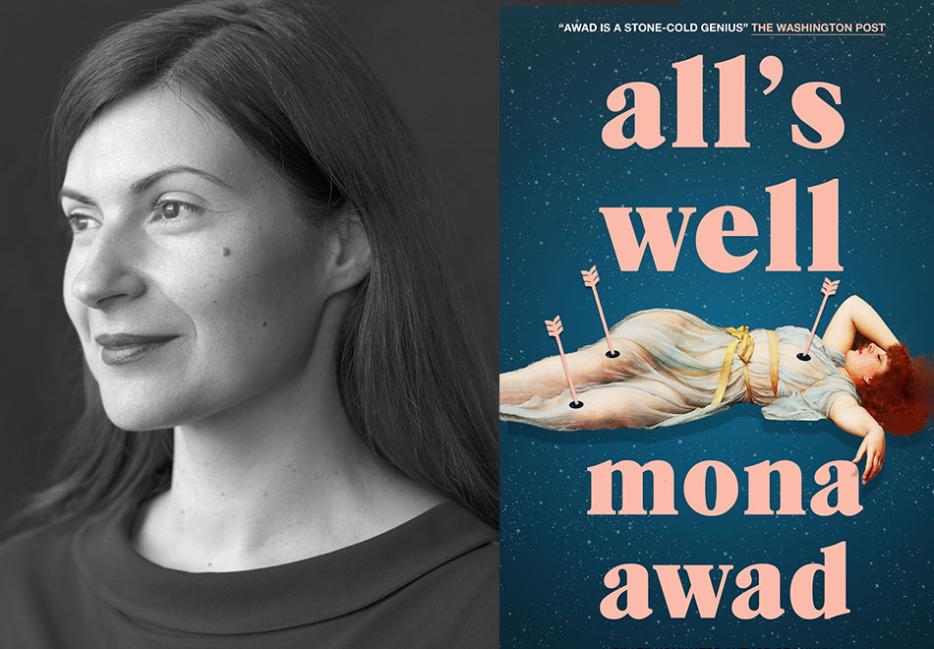“Our remedies oft in ourselves do lie, which we ascribe to heaven,” says All’s Well That Ends Well’s Helen early in the play. It’s a sentiment not at all helpful to Miranda Fitch, the erstwhile actress and current beleaguered drama professor of Mona Awad’s off-kilter novel All’s Well (Hamish Hamilton). Miranda might well know that the pain she feels constantly radiating from her back and leg shouldn’t still be affecting her, and yet the pain persists.
Struggling through a failed marriage, entitled students, and a roster of doctors no longer receptive to her suffering, there seems to be no hope for Miranda until three men, ominously gathered in a local bar as if in Twin Peaks’s Black Lodge, offer her respite. Suddenly, there is no more agony; every part of Miranda’s once-stalled life now teems with possibility.
In All’s Well, fantasy blurs with nightmare as pain is suffered and then shed, with dramatic, Shakespeare-worthy turns of fate transforming what was once a curse into a terrible, powerful gift.
Alyssa Favreau: A good place to start is this novel’s treatment of chronic illness. Why was it important for that to be the central theme?
Mona Awad: I started there. I started with an interest in exploring chronic pain because it’s something that I suffered from for a number of years and had been living with daily, not really [being] able to find relief, trying all these different doctors, and going to different surgeons. I’d had surgery on my hip and just couldn’t find a solution for it and had to live with it. And so I really wanted to explore what it’s like to live with that every day and the ways in which it impacts so many aspects of your everyday life.
And it made me really dreamy, made me dream about what it would be like if one day this pain were taken away. I started fantasizing, sometimes quite darkly, about what that might look like, how that might feel. I was reading Shakespeare at the time, and Shakespeare has all these incredible reversal of fortune-type stories, and that was very inspiring. The two just came together like a perfect confluence.
It seems so important, too, that in this story the pain be a woman’s pain, that it be minimized and ignored and disbelieved in such a gendered way. Was that also the story you wanted to tell?
Absolutely. One of the most challenging things about being in pain is just having your experience understood and validated by the world around you. And I think, when you’re a woman, that’s so difficult. Certainly that was my experience with doctors and physical therapists and even in the workplace. And it’s not only harder for people to believe you, but it’s harder for you to believe in yourself when you’re speaking on your [own] behalf. When you’re advocating for yourself, it’s almost like the internalized misogyny just cripples you from the start. We’re just so trained not to believe women, and women are so trained not to believe themselves and not to believe their own experiences. I really wanted to explore that, and with Miranda, of course, it’s even more fraught because she’s an actress. When you are in pain, the act of communicating it, especially something as nebulous as chronic pain … you kind of end up performing it, just to communicate it to someone else. And that act of performance also amplifies the ambiguity and makes you second-guess yourself, even though you have to do it in order to communicate your pain.
That was something that really struck me, the discussion of the performance of pain. The line from All’s Well That Ends Well says it best: “I do affect a sorrow, but I have it too.” Having the pain but also needing to perform it in a way that is legible to others.
It’s such a beautiful, beautiful line from that play. I love it so much because Helen is in pain, but when she says that, we don’t trust her anymore. She says, “I do affect a sorrow, but I have it too,” and the affectation creates the doubt, even though there’s a part of you that knows it’s sincere. That’s what makes it troubling. That’s what makes Miranda troubling. The pain is real, but she is performing it. That line was enormously inspiring to me; it’s really what gave birth to the whole thing.
I was interested in how Miranda is embodied, as well, and her changing relationship to her body. There’s sex. There’s her gourmandise and her trajectory towards having this more balanced relationship with her body. Was that at the front of your mind while you were writing?
Yeah, because you’d think that pain would make you more in touch with your body. And it does in a lot of ways because you’re so hyper aware. You’re just waiting. “Oh, God, is this going to get worse? Is it going to get better? I just don’t know.” So it makes you hyper aware of your body, but it also cuts you off from your body in these really strange ways. That’s the experience Miranda has. Initially she’s extremely cut off from her body, and then her relationship to it changes as her relationship to her pain changes. That was very intentional for her to go through a journey with her body. And she’s an actress, so she already has a very particular relationship to her body. That was very important, that arc.
From a writing perspective, how did you approach creating the claustrophobia of Miranda’s pain?
It was pretty easy. It’s something that I experienced, so I could really tap into my experiences of being in that place. I don’t usually say that writing is cathartic, but it was cathartic to give expression to that because pain is so difficult to communicate. There’s a scene where she’s trying to tell her physical therapist about her pain, and she’s like, “It’s red and it’s throbbing and it feels like there’s a chair on my foot.” And he’s like “Red… Throbbing… A chair.” What do you make of that? There’s this absence in language for communicating something as visceral as pain. I wanted to make the language as visceral as possible. I really leaned into that experience of feeling and not being able to give expression. You have to make do with these phrases and these metaphors that don’t quite do it justice.
I’ve never thought about it that way, of writing as creating the language of pain. That’s fascinating.
It was actually fun.
The novel takes place in a college drama department, and the dynamics and quirks of the Shakespearean production are so perfect. What’s your history with the theatre?
I was really into theatre in high school, and then I kind of dropped away from it and fell in love with English literature, [though] I still was really interested in the plays and would go see productions whenever they were in town. Shakespeare really, really became important to me when I was in pain. I was a graduate student [when] chronic pain first came into my life. I was taking a Shakespeare class with these reversals of fortune, these story arcs where your whole life could really change. The story of All’s Well That Ends Well is wonderful because a king is actually healed in the play. This young nobody orphan, this clever wench, actually gets what she desires, even though the play begins and she’s completely powerless. She manages to overturn the whole world of the play and get what she wants, and I found that really troubling when I first read it. But there is something about her agency in this world—where she starts off being so powerless—that was exciting to me. I really wanted to capture that. And it felt really kindred to Macbeth as well, so I started thinking about the two plays together.
I’d like to ask you about that—how, with the ways in which the two plays interact with each other, it almost seems like one is haunting the other. Why these two plays in particular?
One is on stage—All’s Well That Ends Well—and that’s of course the life that Miranda wants. It’s the comedy with the bizarrely happy ending, the improbable love. That’s the life that she wants for herself, and she’s trying desperately to stage it. The life that she is living off stage is, of course, the life that she doesn’t want, the play she doesn’t want, the tragedy: Macbeth. But there is a through line between those two plays, even though one’s a comedy and one’s a tragedy. Both are about these outlier characters who at the start of the play don’t seem to have any power within the world of the play, or they have less power than they want. And then they have to take this wildly transgressive action in order to make their desire come true, to make it manifest. That’s kind of how I see the two of them speaking to one another. One goes down the road of comedy, and it’s light and nobody dies. The other, of course, goes down the road of tragedy, and there’s murder and madness and beheadings. I wanted to explore both, one on stage and one off, because I think it’s the same story ultimately.
I was really struck by the fact that witches are such a prominent figure in both plays. You’ve got Macbeth’s three witches in the form of the three mysterious gentlemen, and how their destructiveness begins to overwhelm a more healing and generative magic that All’s Well That Ends Well’s Helen has.
I love that crossover. Helen does have a witchiness in All’s Well That Ends Well, which is part of the reason why I love her. She’s got this strange trickster energy. She can heal a king and get what she desires. It’s all very strange. And then the three witches in Macbeth are so fascinating. To what degree do they orchestrate the whole thing? To what degree does Macbeth really have free will? It’s one of the great ambiguities of that play. I wanted to play with that in this book. There are two different kinds of magic, and both kinds of witchery are in the novel: that kind of good, healing energy and then the more malevolent energy of the Macbeth witches.
All’s Well That Ends Well is famously one of Shakespeare’s problem plays. Do you see this novel as a sort of problem play?
Definitely. I see it as tragicomic, which probably is what makes it a problem play or problem novel. But I also see it as the most honest expression of what I could have done as a writer engaging with these two plays, because I love the way that tragedy informs comedy and comedy informs tragedy in storytelling. I love when that happens in storytelling. That’s when you get the most potent comedy and that’s when tragedy is the most moving, when they’re walking hand in hand. And so, in this book, I really tried to do that. I tried to create both experiences simultaneously for the reader.
I was surprised by how inspiring I found Miranda’s bitterness. It seems like a kind of resistance to have her be so angry and so ungracious and disillusioned with everyone around her. Was that always part of her DNA or did it manifest in the writing of her?
She surprised me. She’s both the hero and the villain of her own story because she is both a kind of Helen and a kind of Macbeth/Lady Macbeth figure. I could have fun with her villainy as the book progressed. She’s been suffering for so long, and suffering corrupts you. It does things to your heart. It does things to your brain. And Miranda’s not immune. And then the sudden absence of suffering, the euphoria that comes after the suffering has ended, that’s another kind of strange filter through which to experience the world. That changes you too, changes your ability to empathize and see clearly and respond to people. I had fun with that, and I think it’s part of her humanity. To not go completely there with her would have been doing a disservice to her humanity.
When she does manage to pass her pain on to others, it reads almost as a revenge fantasy, as if giving the pain to others is a way of being believed and taken seriously.
Yeah, yeah. “Feel it. Feel what I’ve been feeling. And then you’ll know that it’s not a lie.” That’s the dream of people who are in pain, or at least it was my dream, sometimes, with doctors who didn’t understand or who would just blink at me. “I wish you could feel this, because then you’d know, you’d understand my desperation.” It’s a way of creating empathy, where maybe there is no empathy, even though it is a revenge fantasy at the same time.
This novel has some overlap with your previous book, Bunny. I’d be interested in hearing you talk a bit more about that and whether you were interested in creating a through line for your readers from one novel to the other.
There are definitely parallels. Obviously there’s still interest in the supernatural. There’s interest in the fantastic, in witchery and the occult. Bunny has all of that. Interest, too, in New England, that Gothic setting, and in the college campus. I love the fact that All’s Well also has that school year arc. There’s something about it that feels very comforting to me. It was fun to revisit a college campus again. And I love the tensions and the power dynamics that you find in a school. School is like a microcosm of the world. In Bunny, we experience the story from the student’s perspective, and in All’s Well we’re seeing things through the eyes of a teacher. I was surprised at the degree of powerlessness that Miranda feels as a teacher; it’s not really something that I fully understood until I became a teacher myself. I always thought as a student that teachers had a lot of power. They were kind of intimidating. But now as a teacher I realize I have no power; it’s all a performance. Students have a lot more power than they realize. Young people have a lot of power. It was kind of fun to explore the other side of the desk that way
Both novels have this way of manifesting a new reality through artistic expression, too.
Absolutely. It’s true. Miranda’s vision for All’s Well That Ends Well gives so much expression to her interior anguish and also her longings. And that’s also the case for Bunny, for the Bunnies and for Samantha. Their creations are the expressions of their fears and desires.
You’ve got this amazing ability to create these kinds of manic funhouse-mirror worlds where reality and delusion is so blurred. What appeal do these worlds hold for you?
That anything is possible. It’s the realm of the imagination. Anything becomes possible. In Bunny, the fact that I was looking at the world through the eyes of a writer in an MFA program allowed me to open up the borders of reality. In All’s Well, the fact that it’s theatre fiction [meant] I was able to do the same thing. Even though the stage is a physical thing in the book, it extends far past the school’s stage into the world of the novel. And that allows for anything to become possible, allows for theatrics to take place in any realm, in any part of the world of the novel. That was so exciting to me.
The phrase “all’s well” gets repeated a lot throughout the text and takes on such power as both this kind of invocation that darkly manifests, but also as a reassurance that sometimes all does end well.
When I first read the play, I thought that that was such a dark phrase: “All’s well that ends well.” Well, what came before? There could have been all of these terrible things, but one can still say, “all’s well that ends well,” and it sounds good. I remember when I first started reading the play, I kept picturing this woman straightening towels in a bathroom [while] her house was on fire. And that ends up in the book as a memory Miranda has with her mother. I pictured this woman saying it as a mantra to herself, even as her life is falling apart. It has a lot of darkness, even though it’s a reassuring phrase. I like that it’s reassuring, [even though] it has the potential to hold a lot of darkness and mystery in it.
Do you see this as a hopeful novel?
Yes, absolutely. And I wrote it as such. There’s actually an original ending that’s not so hopeful, but I didn’t stick with it because I didn’t want darkness to win in the end. I wanted hope, and I wanted the redemptive power of the feminine to be there. I do think it’s hopeful. It’s more All’s Well That Ends Well than it is Macbeth in the end.






